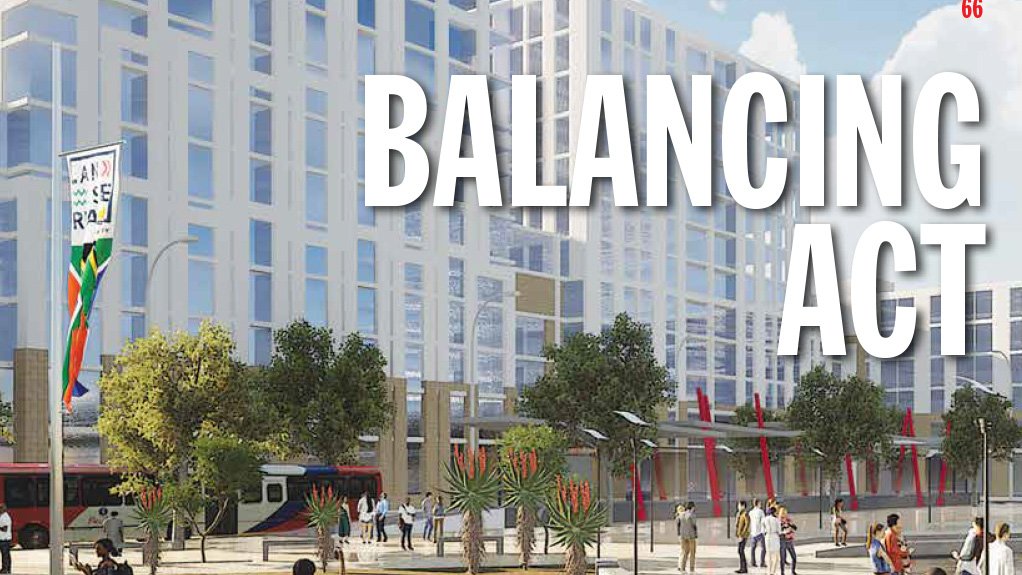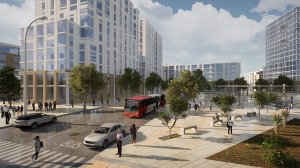New Gauteng urban hub seeks to strike inclusivity, tech-savvy balance



A NEW HOME Between 350 000 and 500 000 people will call the Lanseria smart city home in ten years
The Lanseria smart city initiative, announced by President Cyril Ramaphosa in his 2020 State of the Nation Address, has steadily been gaining momentum over the past two years, despite setbacks caused by the outbreak of Covid-19.
The new urban economic hub is planned to become home to between 350 000 and 500 000 people over the next decade and forms part of government’s Economic Reconstruction and Recovery Plan.
The initiative is being led by the Gauteng Department of Economic Development on behalf of the Presidency and the public sector. However, the smart city development framework, which is based on the Greater Lanseria Master Plan (GLMP), will require innovative financing to succeed because government cannot afford it alone.
The GLMP was the first stage in the development of the smart city initiative. It was the result of a joint initiative led by the Gauteng Office of the Premier that was formed to undertake extensive studies and engagements for the planning of the smart city.
“It’s not within the domain of the fiscus to be able to support the R15-billion needed,” Gauteng Department of Economic Development deputy DG Jak Koseff said during the African Smart City Summit, held in Midrand earlier this year, in terms of the funds needed for the public investment in bulk services, including energy systems, water systems, roads and digital networks.
These funds would need to be gathered through a special-purpose debt vehicle linked to cash flows from future smart city developments.
Additionally, a coordination mechanism would be required that could phase the necessary work into a coordination structure for the new city node – analogous to a city improvement district, but at a larger scale, Koseff explained.
The Inner Focus Zone area of the smart city project will span 28 663 ha, of which the proposed urban structure and development framework concept placed 52.9%, or about 15 162 ha, under development.
The Gauteng Department of Economic Development has said that the delivery of bulk services would be a key public-sector contribution, alongside the creation of a high-tech special economic zone (SEZ), as part of the new smart city. The planned SEZ will comprise a cluster of developments led by the private sector, in alignment with the GLMP, which has been endorsed by the City of Johannesburg, Mogale City and the Gauteng provincial government.
Koseff said the Government Technical Advisory Centre was working with the Gauteng provincial government to conduct a feasibility study and structuring for the high-tech SEZ.
“Clusters of landowners with an investor pipeline are in negotiations with the Gauteng government to set up a real estate investment trust to structure the proposed high-tech SEZ,” Koseff said.
Moreover, the Lanseria smart city project has been submitted as a Strategic Integrated Project but has not yet been Gazetted.
The smart city plan is a response to the forecast population growth of the Gauteng city region from 12.5-million to 30-million over the next 30 years. With urbanisation rapidly spreading, this region is expected to become a megalopolis, similar to São Paulo, in Brazil; Mexico City, in Mexico; and Jakarta, in Indonesia.
The Lanseria region – which lies on the boundary of the Mogale, Tshwane, Johannesburg and Madibeng municipalities – has the potential and necessary geographical footprint to absorb a significant portion of this population growth in a structured way.
The Lanseria smart city development could provide significant economic opportunities by providing a basis for sustainable urban consolidation, building on the existing influence of the well-established Lanseria International Airport and the nearby marginalised communities of Diepsloot and Cosmo City.
The Question of In-/Exclusivity
One of the most prominent concerns regarding the Lanseria development since its announcement in 2020 has been that it would rather manifest as an exclusive, upmarket development targeted at the affluent and tech-savvy, thereby excluding a large majority of South Africans who are not able to afford such a lifestyle.
Independent sociopolitical commentator and analyst Bongani Mahlangu criticised the project on Power FM a year after it had been announced, predicting that it was “not meant for the masses, particularly the poor”, with various others publicly voicing similar concerns since.
After the GLMP was released, construction and engineering company SMEC South Africa’s urban development team – appointed by architectural firm GAPP Architects/Urban Designers to be the project manager and infrastructure and transportation planner for the GLMP – said the Lanseria smart city initiative would not and should not reflect an “extravagant tech-heavy city”.
Rather, the focus would be on implementing innovative technologies to make the smart city and its services sustainable, and on providing inclusive social and economic opportunities to change the apartheid spatial architecture.
SMEC added that the Lanseria smart city would be planned to transcend the digital divide, contributing towards the creation of a new regional city node, which would result in attracting investments, and in providing a conducive environment for job creation and opportunities for communities in and around the Lanseria area.
“Sustainable development guided all aspects of the masterplan and resulted in a plan that encourages the adoption of new technologies,” SMEC urban development function manager Deon du Plessis said.
To allay concerns about exclusivity, Koseff said that at least 50% of the housing that was planned for the Lanseria smart city initiative would need to be subsidised or cross- subsidised to maximise inclusion, and that the smart city needed to be purposefully designed to be inclusive of lower- and middle-income households.
He stressed the importance of avoiding the recreation of what he called “the N1 problem” – where the low-income and underdeveloped Alexandria is located next to the high-income and well-developed Sandton, fostering resentment and greater separation between the social strata.
Office of the Presidency investment and infrastructure head Dr Kgosientsho Ramokgopa has also stressed the importance of ensuring that South African smart city development should be aimed at addressing equity and the upliftment of the poor, rather than simply the development of high-tech hubs focused on connectivity.
How Smart?
While the GLMP focuses extensively on inclusivity and sustainability – with proposals for power generation, including waste-to-energy, microhydro, solar and biogas, as well as all residential and commercial buildings needing to have a Green Star rating of between four and five – information and communication technology (ICT) infrastructure would still underpin the smart city concept.
Although all structures will be geared towards energy and resource efficiency, and constructed using environment-friendly, nontoxic materials, all-inclusive fifth-generation connectivity will drive the local economy and provide high-speed Internet for all residents and businesses.
A planned mobile application would be used by residents for a variety of day-to-day functions and conveniences, as well as for reporting infrastructure and service delivery issues.
A citywide, closed- circuit television camera system has also been proposed, which will use facial recognition technology to identify lawbreakers.
In terms of the architectural design, the GLMP said the development would not feature any “eye-candy or glitzy soaring towers of chrome and glass architectural expression”.
The masterplan insisted that no reference to “gimmickry” would be tolerated concerning localised aspects of energy capture, efficiency or generation, or in terms of isolated examples of low-carbon footprint movement systems that “pretend to mitigate the fundamentally damaging impacts of cities that are otherwise structurally inappropriate in how they are configured or operate”.
“We are transforming what is largely open space into a higher-density urbanised development that is accessible to multiple income categories and classes,” Koseff said.
He stressed that the development of the Lanseria smart city had to be achieved, despite the recent history of coordination failures, which were driven by Lanseria’s position at the urban edge of four different municipalities – none of which had the wherewithal to be fully responsible for the implementation of the Lanseria smart city’s bulk infrastructure requirements or the management thereof.
Koseff noted that, in the absence of a State-led smart city plan, the result would be a series of golf estates and warehouses colliding with the occasional informal settlement – which would be a wasted opportunity to create a more unified and productive urban centre.
Smart Scammers
One of the biggest fears that could surface in connection with large-scale investments is that unscrupulous individuals will use it as an opportunity to enrich themselves using illegitimate means.
Scammers have already started to use the Lanseria smart city initiative to swindle companies and individuals by issuing a false invitation to tender in the name of Crosspoint Property Investments and, most recently, Southern Sphere Property Investments.
The fraudulent invitation to tender solicits bids from professionals and service providers for part of the build phase of the smart city, requiring them to pay an upfront fee of R15 000 for the tender documents – which do not exist.
The Gauteng Department of Economic Development has confirmed that this is a scam and has advised all businesses and members of the public to be aware of it.
The department has appointed the Development Bank of Southern Africa (DBSA) as the implementing agent for the Lanseria smart city and has been planning to undertake roadshows to introduce the project management team to developers once the team has been appointed.
Any communication regarding the development purporting to be from the leadership of the Lanseria smart city initiative that has not been issued by the Gauteng provincial government, the Presidency, DBSA, the Gauteng Technical Advisory Centre or the nominated project management team should be treated with scepticism and caution, the department warned.
Comments
Press Office
Announcements
What's On
Subscribe to improve your user experience...
Option 1 (equivalent of R125 a month):
Receive a weekly copy of Creamer Media's Engineering News & Mining Weekly magazine
(print copy for those in South Africa and e-magazine for those outside of South Africa)
Receive daily email newsletters
Access to full search results
Access archive of magazine back copies
Access to Projects in Progress
Access to ONE Research Report of your choice in PDF format
Option 2 (equivalent of R375 a month):
All benefits from Option 1
PLUS
Access to Creamer Media's Research Channel Africa for ALL Research Reports, in PDF format, on various industrial and mining sectors
including Electricity; Water; Energy Transition; Hydrogen; Roads, Rail and Ports; Coal; Gold; Platinum; Battery Metals; etc.
Already a subscriber?
Forgotten your password?
Receive weekly copy of Creamer Media's Engineering News & Mining Weekly magazine (print copy for those in South Africa and e-magazine for those outside of South Africa)
➕
Recieve daily email newsletters
➕
Access to full search results
➕
Access archive of magazine back copies
➕
Access to Projects in Progress
➕
Access to ONE Research Report of your choice in PDF format
RESEARCH CHANNEL AFRICA
R4500 (equivalent of R375 a month)
SUBSCRIBEAll benefits from Option 1
➕
Access to Creamer Media's Research Channel Africa for ALL Research Reports on various industrial and mining sectors, in PDF format, including on:
Electricity
➕
Water
➕
Energy Transition
➕
Hydrogen
➕
Roads, Rail and Ports
➕
Coal
➕
Gold
➕
Platinum
➕
Battery Metals
➕
etc.
Receive all benefits from Option 1 or Option 2 delivered to numerous people at your company
➕
Multiple User names and Passwords for simultaneous log-ins
➕
Intranet integration access to all in your organisation



















